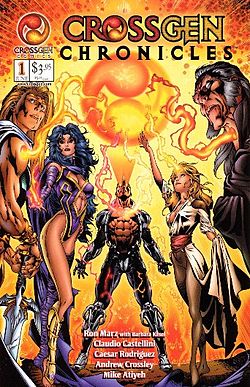
A compan
In 2000, CrossGen Comics launched. Founded by millionaire Mark Alessi, CrossGen sought to expand the comics industry by forgoing super-hero titles and focusing on the Sci-Fi, Fantasy, Victorian Mystery, and Sword and Sorcery genres. Each of CrossGen’s titles stood on their own but was tied to a greater mythology thanks to a Sigil, which was the source of many characters powers.
The “sigil bearers” were supposed to join forces against a cosmic threat called the Negation in the mini-series, NEGATION WAR that would cap off four years of stories. Unfortunately, CrossGen went out of business after the second issue shipped? So what would’ve happened? Only NEGATION WAR writer Tony Bedard knew, until now…
I reached out to Tony to find out his plans for NEGATION WAR. Who’d live? Who’d die? How would the series end? Click to find out.
How did you join CrossGen?
TONY: I was working as an editor at DC/Vertigo and got a call from Mark Waid asking if I’d like to write for them. I had worked with Mark as an editor on his JLA run and we got along great, but I’m still not sure what told him that I’d make a good writer. I just know that I had wanted to write and leapt at the opportunity. I flew down for a visit and interview and got the job. It was nerve-wracking to leave a stable position at DC for the unknown in Tampa, but it turned out to be a great opportunity and I can never thank Waid enough for making that happen.
What was your initial impression of the company?
TONY: It was definitely unusual to have a comic company where all the talent was in-house on salary, but it reminded me a lot of Valiant, the publisher where I got my start. Valiant also had a lot of artists working in-house and I loved the daily interaction with them. CrossGen was like Valiant on steroids, with amazing A-level talent at every step of the process. Being able to watch Jimmy Cheung, Brandon Peterson or Steve Epting drawing pages, John Dell inking, Laura Martin and Justin Ponsor coloring — it was like a hothouse of creativity. I think a lot of people back then wondered if it was like some sort of cult compound, but it was more like a school. Everybody learned from each other on a daily basis. And everybody posted copies of their work at the cubicles so you’d wander through the place and think, “Damn, I’ve gotta get my game up if I’m going to compete with these people.” It just made you want to bring your A-game. The flip-side of that was that it could feel a little intimidating. I had just moved my family to a new town and had to justify my existence there, so I started out a little afraid that I couldn’t play up to their level.
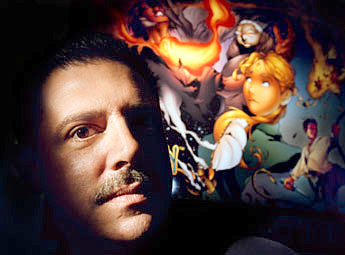
CrossGen Founder and CEO Mark Alessi
A lot of Valiant talent wound up at CrossGen. Why do you think that was? How would you compare Mark Alessi to Jim Shooter?
TONY: Well, it was probably because Bart and Ron were there, and they had met the talent pool at Valiant back in the day. I remember I wanted to recommend Valiant inker Tom Ryder to them, but they were already way ahead of me on that one. Those guys are pretty sharp. As for the Shooter/Alessi comparison, the weird thing is that immediately after Valiant I worked for Jim Shooter at Broadway Comics for a few months. I had heard all these horror stories about Shooter, but the whole time I worked for him him he treated me like a prince. Now, I don’t think you get that many bad stories about you without there being something to it, but I never personally experienced that side of him. I think the takeaway is that people are never the caricature you hear of them. I think both were headstrong people who pushed others hard for results. Also, being the Boss means you can’t be friends with everybody. But if I run into someone who hates either one of them, I’m not exactly surprised. I got along with both of them, so I guess I got off lightly.
Mark Alessi. What’s your take on him? I’ve read people say he’s alright but I’ve also heard he was a tyrant. Is the truth somewhere in the middle? Did you get along with him?
TONY: I had the benefit of working for some pretty forceful people with larger than life personalities before coming to CrossGen, so Mark wasn’t my first boss like that, and far from my worst. But he’s an “alpha-male” type and that can be a bit of a shock for many of us sensitive creative types. Mark was sort a double-edged sword — the same aggressive, bullheaded bravado that turned off some folks was also the quality that enabled him to start up CrossGen in the first place. The guy had brass balls and a sense of his own infallibility which can be a real asset when you’re an upstart taking on industry giants like DC and Marvel. But he came on like a tsunami and so if anyone felt he was overbearing, I get it.
Now, I got along pretty well with Mark, but I think that had to do with an encounter we had early on. When I came aboard, my first assignment was to take over writing Mystic from Ron Marz. I was totally excited about working with Brandon Peterson, and I knew I had to come out of the gate strong. So I included a scene where Giselle’s artist friend Thierry is going to paint a portrait of her. He turns around and is surprised to find she’s disrobed. He’s flustered because he wasn’t expecting to paint a nude. She’s embarrassed by his reaction, and awkward romantic hilarity ensues. Of course, we didn’t show full nudity. Brandon set the shot from behind her with Thierry reacting from background. I thought it worked wonderfully. It was a little naughty, but innocent at the same time. I should have known I was playing with fire when Brandon first saw the script and had this reaction like, “Okay, Tony, it’s your funeral…” Sure enough, I’m sitting in my office trying to think of the next plot when Mark barges in and throws the pages contemptuously on my desk. “What the hell are you trying to do to me?” he demands, and not in a friendly tone. “They’ll skin me alive in the Bible Belt for publishing this!” Well, I was nervous and stressed-out from relocating my family, wondering if I had just made a big mistake, and when he got in my face like that I kinda snapped. I jumped up out of my chair, leaned across the table, and practically snarled, “What am I doing?! I’m trying to get your audience to come back for the next issue! I’m trying to challenge them and give them something to talk about! I’m trying to make this fucking book interesting!” And for half a second I thought I’d just talked myself out of a job, but Mark gave me this look and said, “Okay. I get that. But we need to make some adjustments to the art, and you need to remember we want to sell in Wal-Mart and places like that.” And I don’t think we had a serious disagreement after that. I think Mark just wanted to see that you had a reason for what you did and you could back up your work. If he came after you and you didn’t stand your ground, you were in much worse shape with him. Then he might never stop needling you.
Anyhow, the guy spent a fortune to give us all a chance to do our best work, so I don’t have any ill feelings toward him.
What did you think of the interview Alessi recently did?
TONY: I enjoyed it. It was the first time I heard his voice in years, and he definitely has his own take on events and how things went down. He had a few personal beefs that he mentioned that left me a bit incredulous. I also didn’t recall anything about the Steven Spielberg story he recounted, but maybe I just wasn’t in the loop. But that’s the way these things happen — people all come away with their own version of events. It was like that when Valiant went down. Different people loved or hated different other people. It’s the nature of the beast. Anyhow, I wish Mark well.
What was your day like at CrossGen? Was it nice being able to walk down the hall and talk to your artist while you were writing an issue?
TONY: I liked getting in early (around 8 AM). Writers were among the few at CrossGen with their own offices so I’d shut the door and get cracking on a script. Once more people came in I’d take a break and walk around the floor, visiting the creative teams on the books I wrote (MYSTIC, NEGATION, ROUTE 666, KISS KISS BANG BANG). Each book had its own cubicle section where the penciler, inker and colorist worked near each other. This allowed for free communication throughout the production process and I really think that helped everyone get in synch with each other. We had a lunch room where we’d often have meals together. Often I would verbally pitch the next issue of a given tite to my creative team and just watch their faces as I went through every beat of the story. If they didn’t like something, I’d stop, we’d discuss it, and often I’d change it. Even more often they would suggests little bits of business that I’d work into the story. The result was a true collaboration, where even the inker and colorist had input and felt creatively invested in the story. I didn’t want them to execute “my” story — I wanted us to tell our story. To this day, I don’t think I’ve ever gotten better work done. This system wouldn’t work for everyone, but I love collaborating so it worked for me.
Of course, having all those personalities under the same roof also resulted in some weird office politics, rivalries, and so on. But that happens in pretty much any office. For me, the positives far outweighed the negatives. And I think even people who didn’t like working there came away from CrossGen better at their craft. You couldn’t help but learn from watching everyone else’s creative process day after day.
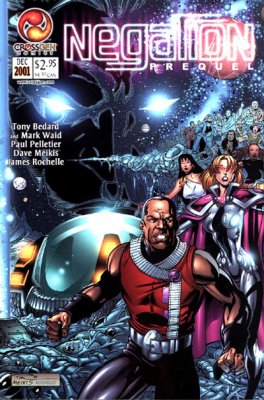
When you started working on NEGATION and MYSTIC, how much of the overall “Sigilverse” storyline were you aware of? Was there a “CrossGen Sigil Verse Bible?”
TONY: I didn’t know much when I started, and as I recall there was a story bible and documents establishing the worlds of the CrossGen Universe. Anything I needed to know I could find out by walking down the hall and asking Ron, or Bart Sears, or Barbara Kesel. But there was also room to improvise and expand on the Sigil concept. Especially on NEGATION, which was set in its own universe and yet drew on bits of every other book we published. The characters in NEGATION had been gathered from all the different worlds where MYSTIC, THE FIRST, SIGIL, CRUX and other CrossGen series were set. NEGATION was treat — I got to establish a lot of stuff in that book and I always felt like the challenge was to outshine any book that our characters were tied to. I’m not saying that it did, but I approached it that way. I wanted The First characters in NEGATION to read better than they did in their own book, and so on. I also hoped that NEGATION readers would become interested in checking out the books that our characters were tied to.
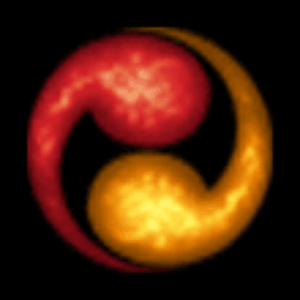
More then a Corporate Logo: The Sigil was the source of power for CrossGen’s characters.
CrossGen’s books were all part of a major storyline. Yet, the individual books had a tight, specific focus that allowed a casual reader to pick up an issue and follow one specific books without having to worry about reading other books. I’ve noticed this formula resembles how Marvel structures their movies. Is it fair to say the CrossGen formula formed the foundation of the Marvel Cinematic Universe?
TONY: No, I wouldn’t go that far. I think every shared-universe line of comics strives for that ideal, where each series stands on its own and yet work as part of a greater whole. It was that way when I started out at Valiant, and those guys had learned it from working at Marvel. To me what’s significant is how Marvel applied that longstanding formula fro comics to their movie slate. And it’s worked brilliantly. Maybe it wouldn’t have 30 years ago, but today’s audience is more conditioned for mega-story and interconnected I.P.s.
How much did you collaborate with your fellow writers? Did you give input on your colleagues titles?
TONY: We would meet regularly to plan out upcoming stuff, but we each “owned” out books. I didn’t really have input on THE PATH or WAY OF THE RAT or whatever, and I didn’t want it. I always saw it as a friendly competition. Everyone there was trying to creatively one-up everyone else, and it raised the bar for the whole line. We talked craft and shared insights. I think that was most evident in the coloring. Laura Martin and Justin Ponsor were and still are the best in the business, and they shared their techniques with others. Nobody had to make their work like anybody else, but we could all learn from each other. We’d also have weekly departmental meeting, lunches together, plenty of opportunity to give each other “notes” and feedback. And yet CrossGen didn’t have editors. Writers were essentially the editors of their own books. I had an editorial background so that was fine with me. As long as everyone on my book was happy and creatively invested, it worked.
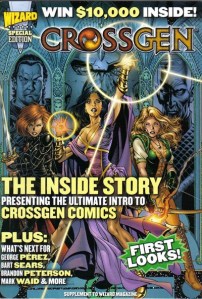
Art by George Perez.
CrossGen came about at an interesting time. Marvel had launched the Ultimate line and was relying on new blood like Bendis, Millar, Paul Jenkins, Garth Ennis, and people from outside of comics, and taking risks. DC, (with exception of Vertigo or Wildstorm) seemed risk averse. Outside of superheroes, the only books gaining traction were crime, horror, and licensed books. CrossGen embraced genres that weren’t being published at the time: Fantasy, Sci-Fi, Samurai, Victorian Detective just to name a few. They also had female protagonists that weren’t bad girls. Would you consider them ahead of their time? Could they survive in today’s market? Was the comic buying public ready for CrossGen when they debuted?
TONY: We were definitely ahead of our time in a few respects — particularly our digital comics initiative, Comics On The Web. 5 years later and the company may have survived. And I loved that we were a “genre publisher.” We did everything but superheroes. It was so cool that in the course of a week I could go from working on sci-fi to fantasy to horror to espionage. The Sigil concept was the original driving force and unifying concept, but I tried to push us to see ourselves as a genre publisher and let that guide how we expanded the line. And in my later titles like ROUTE 666 and KISS KISS BANG BANG I intentionally downplayed the Sigil connections, though they were definitely there. But, yeah, being ahead of the curve in some ways worked against us. I think CrossGen could survive more easily today, though there were other reasons why CrossGen eventually went under.
Yourself, Ron Marz, Mark Waid, Barbara Kesel, and Chuck Dixon just to name a few created some iconic super-hero stories. However, at the time super-hero stories had gotten stale and trapped by continuity. When I read their works at CrossGen their books were “must read” on my pull list. I felt like some of my favorite writer’s were rejuvenated working on these books. Do you feel that playing in different genres rejuvenates you creatively?
TONY: For me, it was a launch point, but others were definitely rejuvenated there. The subject matter of our books allowed guys like Steve Epting and Butch Guice to redefine themselves. Before CrossGen, Epting was kind of taken for granted by the Big Two. Afterward, he was the guy who gave Captain America his definitive run. Greg Land and Jimmy Cheung also showed what they were capable at CrossGen. As for me, jumping from genre to genre forced me to flex different writing “muscles” and kept me fresh. It was a great springboard to some pretty good times at Marvel and DC.
What was it like seeing star artists like George Perez, Bart Sears, Butch Guice. Laura Martin, and Brandon Peterson beside up and comers and rookies like Steve Epting, Jim Cheung, Greg Land, and Steve McNiven? Was there an unofficial “mentor program” amongst the artists?
TONY: There was definitely mentoring going on, but it’s also funny to see Epting and Land referred to as up and comers. Those guys were veterans who found new life there. McNiven is the real up and comer. He started as the Bullpen artist at CrossGen and blossomed before our eyes. I remember seeing his stuff on MERIDIAN and running to the front office to tell Alessi this guy was a freakin’ STAR and to make sure we treated him well. Mark seemed surprised by this. But McNiven made the most of his time at CrossGen and emerged an A-list talent. There were others there who didn’t flourish in that atmosphere, but it was really up to each person what they got out of it. Pencilers met regularly with art directors Bart Sears and Brandon Peterson, and they would just pop in on each other, watching each other’s tricks and techniques, etc. The unofficial “mentoring” was there if you just kept yourself open to it.
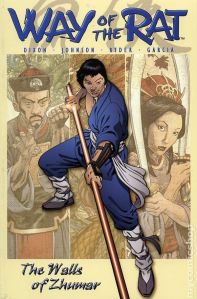
Art by Jeff Johnson
What CrossGen book (other than your own) was your favorite? Was there one you wanted to work on?
TONY: That’s hard to pick. I guess it might’ve been WAY OF THE RAT because I love Chuck Dixon and Jeff Johnson, and because inker Tom Ryder is an old friend from my Valiant days. Those guys really made something special on that book. I made a lot of good friends there. Paul Pelletier (NEGATION) ad Karl Moline (ROUTE 666) remain near and dear to me. I could write for pages about the lifelong friends I met there.
At one point CrossGen overtook Dark Horse as the fourth highest selling publisher according to Diamond. Where did things start to go wrong? Was it a case of expanding too fast?
TONY: It’s funny, but having started out at Valiant in 1992, I had seen this movie before. What it comes down to is that if you reach a certain market share threshold, your terms with Diamond Comic Distributors become more favorable. If, say, you are below 5%, then Diamond might keep half of your sales. But if you go above 5%, then they might only keep a third of your sales. Those aren’t actual numbers, by the way, I’m just trying to illustrate a point: CrossGen was focused on getting above a certain level of total market share so they could make more off every book sold. Valiant had tried the same thing, pumped out a lot of new books, and only ended up cannibalizing their own sales because the existing Valiant fan base couldn’t afford to buy them all. Valiant imploded and I got laid off. So when I saw CrossGen starting to make the same mistake, assuming that more books would equal more sales, I tried to warn Alessi. I don’t think he even heard me. So I just focused on trying to write the best stories I could for as long as we had left. I think I could see that we would go under about a year before we actually did. Like everyone else, I hoped I was wrong, but unfortunately CrossGen had a rise and fall eerily similar to Valiant. Having lived through that before, I wasn’t surprised or bitter, like I had been at Valiant. But for a lot of people at CrossGen it was their first time on hat rollercoaster and I think there are a lot of ex-CrossGen creators who are still kind of bitter about it.
The Disney acquisition. We’re the CrossGen creators hopeful when it was first announced? Why do you think Disney is sitting on these properties?
TONY: I don’t think we were hopeful about Disney acquiring the properties. By the time it happened, I think we all knew it was basically a fire sale and the business had already “burnt down.” As for why Disney is sitting on them, I think they just don’t think there’s a profit to be made off reviving them. Marvel tried to revive a few of them and the response just wasn’t there. And Marvel isn’t in business to lose money, so I don’t blame them.
The Marvel Revival a few years ago. What was your impression of it? I thought it was odd that SOJOURN and MERIDIAN were not a part of that relaunch.
TONY: I’m not sure what decision process went on there. I wrote for Marvel for a couple of years then moved on to DC, and I was with DC when they brought back RUSE, ROUTE 666 and KISS KISS BANG BANG. I was glad that two of those were properties I co-created, but I didn’t pay too much attention since I wasn’t involved in the revival. It’s kind of like seeing your old girlfriend out with a new guy. You wish her well, but you don’t exactly want to watch. I do hope they’ll find some viable way of reviving the properties, or maybe even selling them to someone who will bring the line back the way the current guys are doing with Valiant (and doing it well, I might add!).
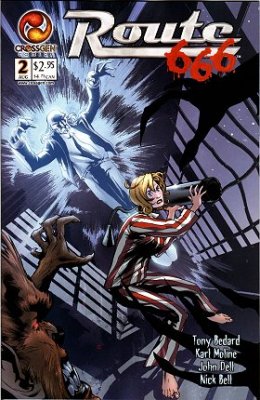
Art by Karl Moline
What CrossGen book do you think deserves a revival as either a comic series, movie, or TV series?
TONY: I’d love to return to ROUTE 666 or KISS KISS BANG BANG. While NEGATION may have been my personal creative high point, it was too rooted in the rest of the CrossGen universe. Then again, it might be the perfect vehicle for reviving the CrossGen universe in one book. Who knows? I also loved WAY OF THE RAT and RUSE. I think MERIDIAN could be made into a great IP appealing to a wide audience.
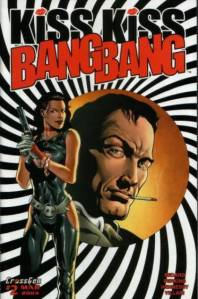
Art by Mike Perkins
What is CrossGen’s legacy?
TONY: The talent. A lot of big stars came out of there, some were new people like Steve McNiven, some like Jimmy Cheung, Mike Perkins and Greg Land had been working in comics for a while but “found themselves” at CrossGen, and some like Steve Epting and Butch Guice completely revitalized already lengthy careers. A whole crop of colorists that had learned from Laura Martin and Justin Ponsor became coloring stars. And most of these folks landed at Marvel. Funny story: when it was clear that the company was going under, I reached out to a contact at DC and to Joe Quesada at Marvel. I’d known Joe since he was penciling NINJAK at Valiant and he’d become Marvel Editor-In-Chief. I told both companies that we had a stable of great artists who would soon be looking for work. My contact at DC asked me to email samples. Joe said he’d come to town that Saturday to meet in person. Now, I want to stress that I love working for DC — they take care of their talent better than any publisher. But in this instance Joe seized the opportunity and I think it led to landmark work at Marvel in the years since by Epting, Cheung, McNiven, Land, Perkins, Peterson, Martin, Ponsor, and others. Whatever your opinion may be of Mark Alessi, he set up and funded a place where a lot of very talented people learned from each other and got the most out of their talent. It was a hothouse of creativity and it’s still the gift that keeps on giving.
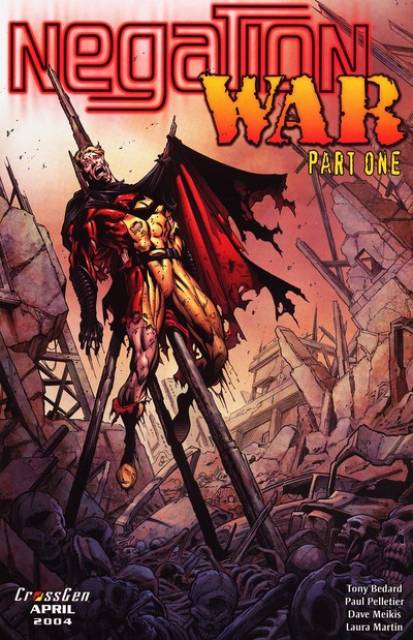
CrossGen’s “Crisis” art by Paul Pelletier
Negation War
Negation War. The big blow off to the entire “Sigilverse” mega-story. How did you land that gig?
TONY: I think NEGATION became an in-house favorite at CrossGen. That’s not to say it was better than other titles, but it combined aspects of the entire CG universe and thus it sat at the nexus of the entire line. And the artwork and sheer genius of Paul Pelletier surprised and delighted us every month. To this day, Paul may be my favorite collaborator I ever worked with. Anyhow, it was a combination of goodwill toward the series and the unique place it occupied in our continuity that led to NEGATION WAR as a means to tying together the various threads of the CrossGen saga.
We’re you and Paul always slated to do NEGATION WAR or were Mark and George going to do it before hand? (It struck me as a project made for George Perez)
TONY: As I recall, it was always me and Paul (Pelletier). NEGATION WAR was decded upon long after Mark Waid had left the company. And while I’d love to work with George someday (he is not only insanely talented but the sweetest guy in the business), I was hitting on all cylinders with Paul at the time and wouldn’t have traded him for anyone.
What did you like about working with Paul?
TONY: Paul is a workhorse. He puts out a page a day no matter what. He takes no shortcuts, either. I remember I had a series of panels that were “stat panels.” That means nothing changes from panel to panel except the characters posture or even just their expressions. It’s a way of doing a little cinematic moment, a give and take in conversation. Usually, the artist draws the first panel, then just draws the changed characters (or even just their changed expressions) in the following panels. Then you copy or “stat” the background and lay it in. I hope that all made sense. Anyhow, Paul would redraw the whole incredibly detailed background in each panel because that’s the kind of guy he is. And I LOVE him for it. He designs amazing aliens and monsters, he draws beautiful people, and whatever is on his mind, he never minces words. This meant we would butt heads every so often, but it never lasted more than a day. And once we got on the same wavelength, Paul gave me one of the most rewarding collaborative experiences of my entire career. I love him like a brother and would take a bullet for him. By the way, I had a different relationship with ROUTE 666 artist Karl Moline that was just as rewarding and profound but in a different way. Either one of those guys, I’d have their babies
Do you have any plans to collaborate again with Paul or Karl somewhere down the line?
TONY: Karl and I are working on a creator-owned pitch at the moment. Time will tell if it finds a publisher. I’d love to work with Paul again on anything, but there’s nothing planned. Whether or not they work with me, I wish them both all the success they deserve. They are both amazing (and in my opinion under-appreciated) talents.
How much of Negation: War did you have scripted or outlined?
TONY: I had a loose outline for all six issues, scripts for four. And it was kind of funny because we were doing the story at a time when morale was dipping and everyone knew the end was near, so the story itself began to reflect some of the office politics at the time.
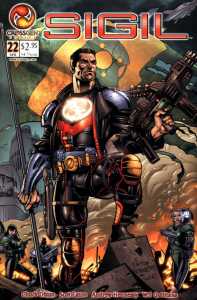
Samadhal Rey star of “Sigil” art by Scot Eaton
We know Sam from Sigil was supposed to gather the Sigilbearers. I’m going to rattle off the names of Sigil Bearers and major players. Can you tell me what they’re roles would’ve been in Negation War?
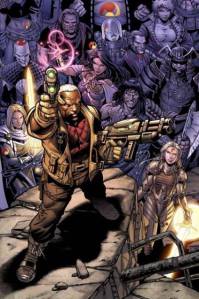
Obregon Kaine from NEGATION taking command.
TONY: Sure. And, by the way, Sam was to get killed by the Negation’s Lawbringers in issue 3, I think, and Obregon Kaine from NEGATION would reluctantly assume leadership of the sigilbearer forces against the mad god Charon.
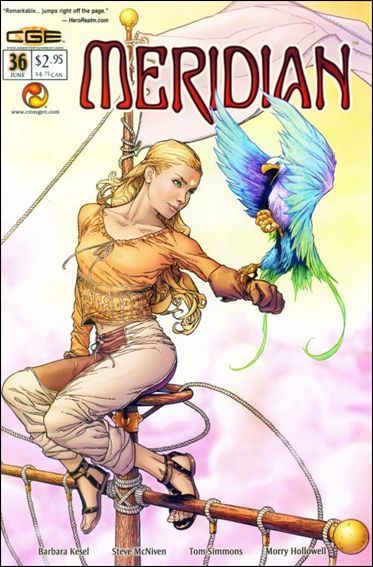
Sephie. Art by Steve McNiven. One of my favorite covers.
Sephie from Meridian. (And Illahn from Meridian for that matter)
TONY: I actually don’t recall Sephie or Ilahn having a big role. I think I would have given Sephie a key moment in a battle, and I probably would have had Ilahn try to make a power play that failed.
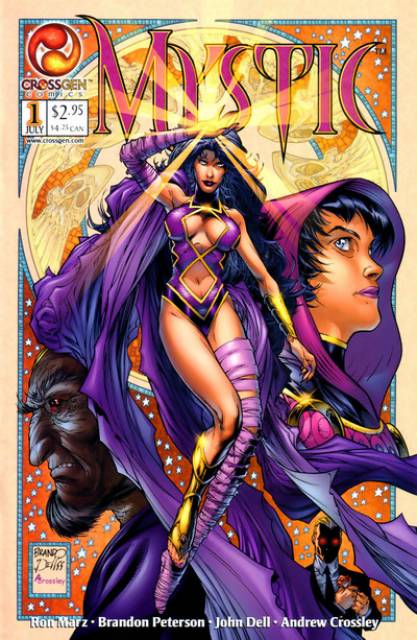
Giselle. Art by Brandon Peterson
Giselle from Mystic.
TONY: Another character that would have just had a spotlight moment in a battle.
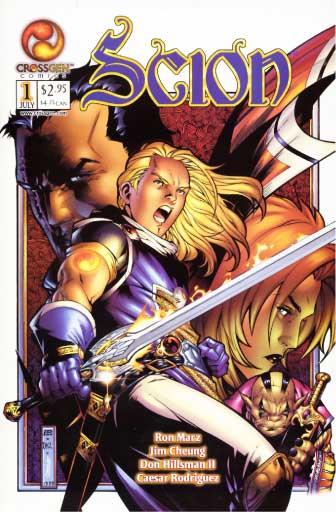
Ethan. Art by Jim Cheung
Ethan from Scion.
TONY: Spotlight moment, but not much more.
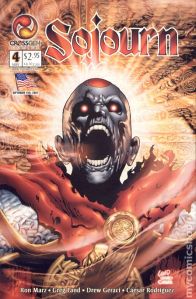
Mordath. Art by Greg Land
Mordath from Sojourn.
TONY: Mordath would have had more of a prominent role, challenging Obregon Kaine for leadership of the resistance against the Negation. I loved Mordath and would have made a strong argument in favor of him leading the good guys, but of course he was an evil bastard, so…
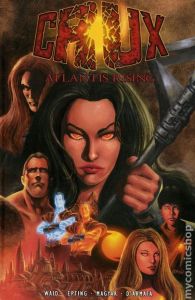
Art by Steve Epting
The Atlanteans from Crux.
TONY: No big role planned, but probably a failed attempt to take out Charon.
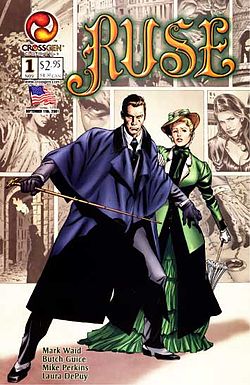
Art by Butch Guice
Emma from Ruse.
TONY: No role planned.
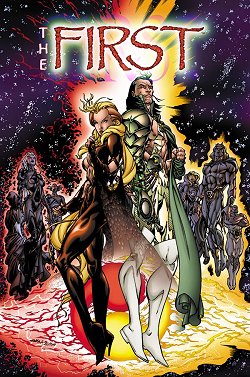
Art by Bart Sears
Was Ayden from Sojourn also Altwaal from the First?
TONY: I actually don’t remember. I don’t think so, though. And The First would have been wiped out by the Lawbringers in NEGATION WAR #4 in an epic battle.
What was the significance of the “Orange eyed” mentors/sidekicks? What was there role in Negation: War?
TONY: All of those sidekicks were aspects or avatars of Danik, the being that originally distributed the Sigils to all their bearers. Every one of them was really Danik in disguise. That would have been a major reveal. The whole Sigil saga really came down to a confrontation between Danik and Charon. They were the two opposing forces and prime movers of the CrossGen Universe. Danik empowered all those people knowing there would one day be a showdown with Charon.
Why did the characters from the Negation series travel to Han-Jin (the world of The Path, Brath, and Way of the Rat)? Was that specific world serve a purpose to the overall saga?
TONY: That was just kind of arbitrary. They needed to gather their forces somewhere, right?
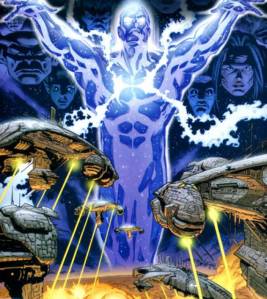
Charon, the Big Bad of the CrossGen Universe.
The series ended with a Negation invasion of the First’s home world. Do you remember what would have happened in each issue?
TONY: Like I said, the Lawbringers would have wiped out the First. Also, Evinlea, who had abandoned the First to join forces with Charon, would have killed Samandahl Rey, star of SIGIL, apparently depriving the sigilbearers of their leader. But Obregon Kaine would have taken up his mantle and just when it seemed there was no way to stop Charon, Kaine would have made contact with Appolyon, Charon’s rival who had been banished to a hellish pocket dimension. Kaine would have learned that Charon and Appolyon were originally humans who had been empowered by an experiment that attempted to recreate an ancient Atlantean experiment that made the Atlanteans Danik and Solusandra into godlike beings. He would have also learned there was a way to reverse that process. It all came down to Kaine tricking Danik and Charon into facing each other in personal combat in Appolyon’s Hell-dimension. (By the way, Appolyon was “The Adversary” often referenced in ROUTE 666). Once Danik and Charon get there, Kaine sets off a bomb that dis-empowers them both, turning them back into human and Atlantean. Then Kaine beats them both within an inch of their life with a toilet. You can see that toilet floating in space in NEGATION WAR #1 among the remnants of a planet that gets destroyed in that issue. I’m not kidding. He beats them with a toilet. Kaine leaves them to the tender mercies of Komptin, his nemesis from NEGATION, with whom he’s finally reconciled. The End.
How do you write a “big event” book? What goes into it? How do you decide which characters get the lion’s share of the spotlight and who is just there? How do you make sure each character gets a “moment”?
TONY: It varies from Event to Event, but first you figure out what you want to accomplish narratively and outline the broad strokes of the story. Then you definitely try to make sure each character gets a moment, but only if it doesn’t detract from the main story. And there are certain focus characters who drive the story. For NEGATION WAR that was Charon, Danik, Sam, Obregon Kaine and Evinlea. It was Negation-centric, but I wanted to do justice to the other books, too. There was also a little bit of wanting to do other people’s characters better than they were done in their own books. I’m not sayng I actually could do that, but you have to go into it with that kind of brash, shoot-for-the-stars approach. It’s all in the spirit of friendly competition.
Of the Sigil-Bearers which one’s were you “drawn to”? What drew you to them?
TONY: Aside from the ones I was working on? (I really did love Giselle from MYSTIC, Mercer Drake, Javi & Shassa from NEGATION and Cassie from ROUTE 666) Well, I loved Boon in WAY OF THE RAT, Sephie in MERIDIAN, and Mordath in SOJOURN. My love for Boon owed a lot to my friendship with the WAY OF THE RAT creative team. All remain good friends. Plus, I just love kung fu movies. I found the concept of Sephie fascinating. MERIDIAN had a Miyazaki appeal, and I love me some Miyazaki. And the idea of a sigil-bearer who was a villain made Mordath irresistible. Plus, he looked like Boris Karloff. Heh.
How was Sam going to die? Who would have been affected by his death the most? Was that an Alessi-edict or something you felt needed to happen? Dramatically, what did killing this character do?
TONY: I don’t remember if it was an edict, but Sam would have led the sigil-bearers to a victory, we would have had a triumphant moment where he’s addressing the troops and everybody feels like they might actually win this thing…and the Evinlea comes up behind him and yanks out his heart from behind. Something like that. It would have temporarily left the good guys hopeless. Then Mordath would have made a play to take over leading the resistance, but Obregon Kaine would have very reluctantly taken up leadership. Everyone would doubt him because he has no powers, but as in the NEGATION series, Kaine would have totally been The Man!
Would there have been a showdown between Kaine and Mordath? How would Kaine defeat Mordath? Would the Sigilbearers have to combine their powers in order to keep him in check?
TONY: There would have been a showdown between the two, but I don’t think I ever plotted it out, so I’m not sure how Kaine would get the upper hand. It may not have even been a fight, but Kaine may have prevailed by reason or trickery. He may have simply shown that the sigil-bearers wanted to follow his lead and would never follow Mordath, but one way or another Mordath would have made a power play for leadership. It’s who he is.
Would you have killed any Sigilbearers beside Sam? Were any others on the chopping block?
TONY: Probably, but I don’t remember exactly who. We were pretty ruthless in NEGATION about killing off characters, so more heads would have rolled in NEGATION WAR.
From your answers, it sounds like the other Sigil-Bearers weren’t going to have as major roles in the book as people thought they were? Since the First were going to be wiped out, were the Sigilbearers going to inherit the Seven Weapons of Altwaal to fight the Negation?
TONY: I kind of doubt it, but I don’t remember having any plans for those weapons. Frankly, with 6 issues, it would have been difficult to do every book real justice. I would have been happy just to give characters face time and a focus moment.
The scripts and outlines to NEGATION WAR. Do you still have them? Would you be willing to post them so fans can get some closure?
TONY: Alas, several computers later, I don’t still have them. No idea what became of them. 😦
What would have happened to the Sigilverse Post-Negation War? Would the titles have ended and the publisher focused on self-contained books like El Cazador and Route 666?
TONY: I have no idea.
What would you say to give Sigilverse fans the closure to the grand story they never received in 2004?
TONY: I can only say that though CrossGen ended abruptly, we went out on a high note. I hope you enjoyed the stories we were able to bring you, and that you’ve enjoyed the work of CrossGen creators in the years since. It was a wonderful moment in all our careers and CrossGen fans were the best fans. I feel honored to have worked there.
If Marvel gave you the opportunity to retell or finish the NEGATION WAR would you?
TONY: Of course! I’m not holding my breath, though. I can’t see that it would be a profitable decision for them. I’ve long hoped they would collect CrossGen stuff, especially KISS KISS BANG BANG. The final issue of that series was penciled,inked and lettered but never got published. THat means they have a complete trade paperback they could publish for just the cost of coloring one issue and printing. Hint, hint, Marvel! 😉
They say nostalgia comes in cycles every 20 years. The 2000’s had the 80’s revivals with TRANSFORMERS, GI JOE, MOTU, VOLTRON, and THUNDERCATS continuing in comics. The 2010’s have the 90’s with Valiant and POWER RANGERS, do you think in the 2020’s there will be demand for a CrossGen revival?
TONY: Who knows? Valiant has experienced its revival. If Disney was willing to sell the portfolio of CrossGen I.P. to someone like the guys currently running Valiant, then maybe we could have that revival. Hope springs eternal.
Thank You to Tony Bedard for taking the time to speak with me. Now, check out this gallery of unpublished pages from NEGATION WAR #3 by Paul Pelletier .
If any CrossGen creators have unpublished art or want to share their experiences working at CrossGen, please email me at todd.matthy@gmail.com.






Thank you for this. Huge fan of ‘Negation’ and happy to see a glimpse of how ‘Negation War’ would have ended. Long live Obregon Kaine.
I’m glad you liked it. I’m hoping to do a series of articles called “Unfinished Business” where talk with writers and artists about storylines that were never completed and how they would’ve ended.